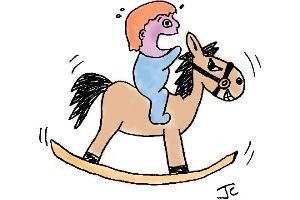 WHILE equine horses are acknowledged as potentially dangerous, another branch of the horse family — the non-equine horses — has quietly infiltrated modern society, and the dangers of their existence have been overlooked.
WHILE equine horses are acknowledged as potentially dangerous, another branch of the horse family — the non-equine horses — has quietly infiltrated modern society, and the dangers of their existence have been overlooked.
When searching the South Australian Injury Surveillance and Control Unit database for presentations of horse-related injuries to a paediatric emergency department over a 5-year period, one of us found a subgroup of data relating to injuries caused by horses of a non-equine nature.
The data were initially discarded, but we faced growing concern that these horses may represent an unrecognised danger to society.
After retrieving these data, we undertook an observational study in an attempt to fill a gap in published knowledge, and provide a discourse on five varieties of non-equine horse that may be responsible for occasional injury, distress and the odd foreign body.
Pommel horse (Lethargicus gymnasticus)
The pommel horse is a large, slow-moving beast often found quietly grazing in the dusty storage areas of school auditoriums and community halls.
It tends to be solitary in its habits and to live in its habitat for months without being disturbed.
Periodically, it is herded to a position of prominence on the open floor by its handlers (known to the wider community as “PE teachers” or “gymnastic instructors”) and surrounded by padded matting.
This is when pommel horses present the greatest danger to society.
For reasons yet to be clarified, children and adults are drawn to jump onto its back and attempt feats of gymnastic daring.
During the study period, three children presented with injuries sustained from a pommel horse (in fact, the same creature).
Two children fell from the horse’s back, presumably when it suddenly bucked or reared.
One child ran into its side after jumping from a springboard (allegedly the pommel horse side-stepped after the child had launched him or herself into the air).
Fortunately for these children, their injuries were minor and they were able to be discharged home with minimal medical intervention.
Rocking horse (Rockerbottom domesticus)
The rocking horse is a common family pet, and many adults have fond memories of these playful beasts.
However, horror filmmakers have recognised their occult potential and highlighted this in films such as The rocking horse winner (1949, and remade several times since).
Rocking horses are highly excitable and most injuries tend to be sustained during riding when the rocking horse suddenly breaks into a gallop.
There appears to be an association between injury and the presence of an older child, especially an older brother, whose behaviour may incite the rocking horse to greater activity.
Unfortunately, rocking horses possess a hard mane and the impact of a child’s face on the mane is often the cause of tears and injuries.
Of the seven children injured by rocking horses during the study period, two came in contact with a particularly highly strung animal kept in the waiting room of the hospital’s radiology department for the amusement of young patients waiting for treatment.
While neither of these children was seriously injured, the rocking horse in question was reluctantly “put down”, much to the distress of the staff who had fed, watered and cared for it.
As South Australia is the home of the “Big Rocking Horse of Gumeracha” (yet another reason to visit the state), it would be remiss not to include an injury that occurred during an attempt to scale and ride this giant beast — one child sustained minor head injuries after falling down a ladder on the way to the top.
Dr John A Craven is a paediatrician and emergency physician in the Emergency Department at Canberra Hospital, ACT, and Dr Jacquie K Schutz is a paediatric emergency physician in the Department of Paediatric Emergency Medicine, Women’s and Children’s Hospital, Adelaide, SA.
The full version of this article is published in the Medical Journal of Australia.
This article is reproduced from the MJA with permission.
Posted 13 December 2010

 more_vert
more_vert
As a paediatrician living and working in a rural setting my knowledge of the epidemiology of injuries involving members of the genus Equus other than the familiar Equus ferus caballus (domestic horse) was scanty.
I had assumed such injuries would have been as rare as rocking horse dung. Clearly I was mistaken.
I am indebted to Drs Craven and Schutz for bringing this issue to our attention. We will need to carefully review our accident data to ensure that species and sub species specificity is recorded adequately in future.
Bathurst, NSW